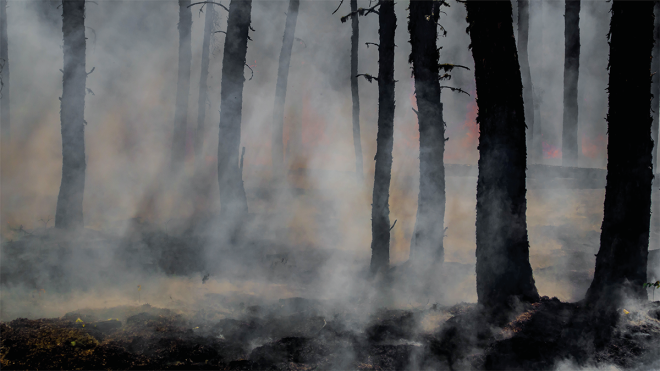Mitigating Wildfire Risk through Smart Grid Monitoring

Distribution Transformer Visibility is Critical
By Charlie Nobles, Ubicquia’s utility business development Vice President
As I write this blog, fires burn across Canada, and in the U.S. the National Interagency Fire Center reports that nearly 25,630 wildfires have destroyed more than 731,000 acres between January and early July of this year. The North American Electric Reliability Corporation (NERC) predicts increased wildfire danger across both countries.
Electric Utilities Have a Responsibility to Reduce Wildfire Risks
Most wildfires result from nature, such as lightning strikes, or human activity, such as unattended campfires or arson. Yet according to the National Interagency Fire Center, five percent of wildfires are caused by electric utility infrastructure, such as power lines and transformers.
Communities and government authorities expect electric utilities to be responsible for reducing the risk of wildfires caused by their infrastructure and operations. Failing to plan and mitigate wildfire risks can cause devastating loss of life and property, such as the 2018 Camp Fire in California. And the costs to the utility go beyond restoring service and infrastructure.
In June of this year, an Oregon jury found the electric utility PacifiCorp responsible for causing wildfires during Labor Day weekend in 2020, ordering the company to pay tens of millions of dollars to 17 homeowners who sued and finding it liable for broader damages that could push the total award into the billions.
Smart Grid Technology Vital in Wildfire Planning and Mitigation
Utilities are actively taking steps to mitigate wildfire risk, and many have developed comprehensive wildfire plans in conjunction with state and federal fire agencies that include:
- Conducting regular inspections and replacing damaged or outdated equipment
- Implementing fire-resistant design and materials such as steel or concrete poles and underground cables
- Monitoring and controlling vegetation near power lines
- Deploying smart grid technologies and sensors for monitoring and control
- Coordinating with fire agencies and emergency responders to prevent and respond to wildfires, such as sharing power system information and risk assessments
Of all these vital steps, smart grid technology offers tremendous value with improved situational awareness that increases overall grid resiliency, providing timely alerts for faster responses to potential wildfire dangers such as shorts and faults.
Bolstering Wildfire Mitigation with Distribution Transformer Monitoring
While deploying smart grid technology strengthens wildfire mitigation with visibility into the grid, that awareness usually ends at the substation and then picks up at the meter. There is a big visibility gap – the “last mile” of distribution transformers.
The distribution transformer visibility gap is a liability, especially in vulnerable residential and commercial areas, as transformers can be overloaded during peak demand and ignite. Lines and poles can be knocked down by high winds, causing fires.
Distribution transformer awareness enables utilities to detect momentary faults caused by vegetation overgrowth, downed poles, sparking from line failure, arcing, overheating, and power surges. All these situations present potential fire danger, and timely alerts allow utilities to respond quickly and mitigate risks.
Harnessing Connectivity, Artificial Intelligence, and Analytics to Close the Visibility Gap
Ubicquia has created a transformer monitoring platform that gives utilities visibility across their service area. DTM+ collects and sends transformer and grid performance data over an LTE network to a cloud-based system that uses predictive analytics, reporting, and visualization to eliminate the visibility gap and help utilities enhance their wildfire planning and readiness.
Utilities cannot do much about the weather or human behavior, but they can work closely with communities and fire agencies to prevent and respond to wildfires. By deploying grid monitoring technology and eliminating the distribution transformer visibility gap, utilities can reduce the risk of wildfire, help save lives and property and ensure the communities they serve have safe and reliable electricity.
Check out our Wildfire Solution Sheet and learn more about Ubicquia's smart transformer and grid monitoring solutions for utilities.
About Charlie Nobles
Charlie is the VP of Sales for Ubicquia and heads Ubicquia’s utilities segment. He brings a deep knowledge of utility grid operations with 25 years of experience, including roles at Progress Energy (now Duke Energy Progress) and vendors that support utility operations.
Charlie is also a recognized leader in the utilities field. He is an active member of several ANSI committees on outdoor lighting and has taught numerous smart lighting controls programs at the IES Street & Area Lighting Conference for the last four years. Charlie holds a B.S. and M.S. in Engineering from Duke University and an MBA from the University of North Carolina at Chapel Hill Kenan – Flagler Business School.

